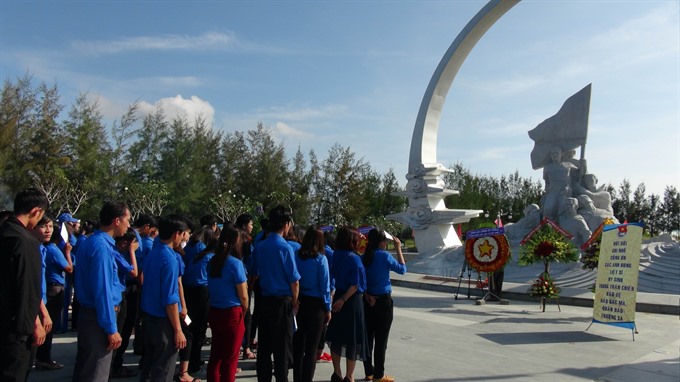 Society
Society

The authorities of the central coastal
 |
| The authorities of the central coastal province of Khánh Hoà and local armed forces gathered on Wednesday to pay tribute to 64 naval officers and soldiers who died in a battle to protect the Gạc Ma (Johnson South) Reef in Việt Nam’s Trường Sa (Spratly) archipelago 30 years ago. — VNA/VNS Photo Phan Sáu |
KHÁNH HOÀ – The authorities of the central coastal
They offered flowers and incense at the monument dedicated to Gạc Ma soldiers built in Cam Lâm District, showing their gratitude to the heroes who bravely defended Việt Nam’s sacred sea and island sovereignty and died with honour on March 14, 1988.
The monument lies at the centre of the 2.5-hectare memorial complex inaugurated in 2017. It features the naval soldiers standing holding hands in an “immortal circle” around the fatherland’s flag to protect it and to affirm Việt
The delegation then visited the complex’s wind tombs and underground museum where the soldiers’ artifacts and personal items are displayed to tell visitors about their lives and unyielding spirit.
At this site, around 200 young people from Cam Lâm District,
The province’s leaders have visited and presented gifts to relatives of local martyrs in commemoration of the historic battle.
The Liaison Committee for soldiers of Trường Sa (Spratly) Islands (1984-1988), in co-operation with Navy Engineering Regiment No 83, hosted a memorial service for 64 Vietnamese naval soldiers who fought to protect Gạc Ma (Johnson) reef, part of the Trường Sa Archipelago, from Chinese invaders on March 14, 1988.
Veterans who worked on the Trường Sa Archipelago, officials, soldiers whose comrades were sacrificed in the battle and local people gathered at Thọ Quang fishing port to release wreaths to pay homage to the fallen soldiers.
“They [Chinese soldiers] attacked Vietnamese soldiers to snatch the flag with a manual battle, but they failed. A Chinese sailor, maybe a commander, used a gun to fire at flag holder Trần Văn Phương, but I then kicked the gun out of the Chinese commander’s hand before taking the flag,” Nguyễn Văn Lanh, who joined the battle in 1988, recalled.
“I was stabbed by a bayonet on my back shoulder and on my chest, but we kept holding the national flag to protect the country’s sovereignty over the islands and reefs,” he said.
“Chinese armed men then returned to their ships and began firing cannons on unarmed Vietnamese naval engineers on the reefs and our ships to kill our teammates,” he said.
Lanh recalled that he fell down, but still held onto the flag before his teammates took him away.
Nguyễn Duy Lập, former commander of Regiment No 83, said the Gạc Ma battle was a historical landmark for the Vietnamese navy in the protection of the country’s islands and sea.
“The battle marked an unforgettable memory in the country’s history. Our soldiers had died for the country’s peace. Their bodies and souls were laid down in the sea forever, and the country will never forget them,” Lập said in the memorial service yesterday.
“The battle on Gạc Ma reef showed off the braveness and faithfulness of our soldiers in protection of every inch of soil and sea of the country’s sovereignty. Sixty-four soldiers sacrificed and 11 were injured, and families lost their relatives,” Lập said.
Teaching of Gạc Ma battle
The battle to defend
The remark was made by Prof. Phạm Hồng Tùng, chief author of the high school history curriculum, in an interview with Vietnam News Agency.
Tùng, who is also head of the history faculty of the
Explaining why the Gạc Ma battle is only being added to the curriculum 30 years since it happened, the Professor said that historians need a certain period of time to collect sufficient documentation and thoroughly study a historical event, especially complicated ones relating to the country’s internal and external relations, before official information can be publicised and taught at school.
Even more prudence is required if the teaching of those events may affect the understanding and thinking of future generations, he said.
“The inclusion of the Gạc Ma battle on March 14, 1988 in history textbooks is the way that we, as historians (and I believe that people nationwide also agree with us), pay tribute to the 64 soldiers who sacrificed their lives in that fight to protect the homeland’s sea and island sovereignty and protect the sacred territory of the fatherland,” the historian said.
According to him, the event will be mentioned four times in the new high school curriculum. He said that it will be part of the history of Việt
That will help future generations be aware that the fight to defend and affirm Việt
In the curriculum for the senior high school level, the Gạc Ma incident will be among the battles to liberate and protect the country’s territorial integrity, and mentioned again in lessons about the
The professor affirmed his viewpoint that the teaching of the Gạc Ma battle must firstly respect the truth, but it must not rekindle feuds or disagreements of the past.
The most important thing is that the teaching must educate students to promote peace and cooperation with not only the Chinese people but also people around the world.
Tùng added that a scientific and humane approach toward peace and cooperation are the consistent viewpoint in the teaching of the wars protecting the northern and southwestern borders and the marine sovereignty of Việt




